|
Image Processing Example - m13 (Globular Cluster in Hercules)
|
The following steps illustrate the processing of an image of m13, beginning with
calibrated image frames, and ending with a finished image ready for web display.
Please be aware that what follows is One way to process this image. There
are as many other legitimate (some much better) procedures as there are other
image processors.
Each of the image thumbnails in the right column can be clicked to reveal a
full-screen image. After displaying a full-screen image, use your browser's "back"
button to return to this page.
This processing example uses the following software packages:
- CCDSharp (Freeware available from SBIG)
- MaxIm DL (Software available for purchase from Diffraction Limited)
- Photoshop CS (Software available for purchase from Adobe)
Where links appear in the text below, it generally leads to another page which contains
a detailed explanation of the steps necessary to carry out the indicated activity.
|
|
Step 0: Images ready to process
|
These image files were taken with an Optical Guidance Systems 32" Ritchey-Chretien telescope
and SBIG STL-11000m camera, from very dark and transparent skies in northwestern Arizona.
The raw files have been calibrated (i.e., Dark Subtracted, Flat Fielded, Hot/Cold Pixels removed),
and aligned with each other.
These files are available to interested users who wish to follow
along with their own software, and/or make their own alterations to the process.
|
Luminance File.
This file is a series of 6 added sub-frames, each of which is an added stack of 4 sub-frames,
each exposed for 1 minute, unbinned, through an SBIG Clear filter.
|

|
Red File.
This file is an added stack of 7 sub-frames, each exposed for 1 minute, unbinned,
through an SBIG Red filter.
|
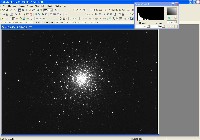
|
Green File.
This file is an added stack of 7 sub-frames, each exposed for 1 minute, unbinned,
through an SBIG Green filter.
|
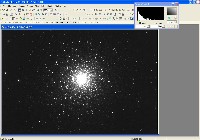
|
Blue File.
This file is an added stack of 7 sub-frames, each exposed for 1 minute, unbinned,
through an SBIG Blue filter.
|

|
|
Step 1: Deconvolve Luminance File
|
The Luminance file is going to be providing the fine
detail in the finished image. Since the sampling scale with the 32" RC telescope
and STL-11000m camera yields about .32 arc-seconds per pixel, this image is what
imagers call "over-sampled."
Generally, this means that it can benefit by some degree of deconvolution, which will
tighten up the star images and other details in the image.
|
Use CCDSharp to do a 3 iteration Richardson-Lucy Deconvolution
on the Luminance Frame. Luminance file shown after deconvolution at right.
|

|
|
Step 2: Non-Linear Stretch of Luminance File
|
Astronomical image data generally has most of the interesting signal in the lower
part of the range of possible pixel values. While a few stars may have saturated
cores, the vast majority of the nebulosity or galaxy detail is not very bright.
As an example, the raw Luminance file is shown on the right with a screen stretch of
zero to 65535 (64k), the full range of this camera. If the image were transferred
into Photoshop in this form, this is what it would look like.
|

|
Use MaxIM DL to do a Non-Linear Stretch (DDP)
on the Luminance Frame, with DDP parameters:
- Background = 950
- Mid-Level = 1700
Luminance file shown after non-linear stretch at right.
|
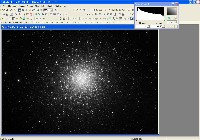
|
|
Step 3: Color Combine Red/Green/Blue frames and do Non-Linear Stretch on result
|
In MaxIm DL, load all three color files and select Color | Combine Color.
Set the color mixing ratio for each filter. These values can be determined experimentally,
by reference to other users of the same filter/camera combination, or by doing a G2V star
calibration.
The values I used for this data set are:
- 1.35 - Red
- 1.00 - Green
- 1.60 - Blue
Note that I have checked the Bgd Auto Equalize button.
|
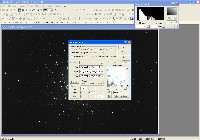
|
This is the result after the above Color Combine was executed.
Note the relatively low values that have to be used on the Screen Stretch in order
to be able to see the details in this image. Some imagers prefer to load the RGB
image into Photoshop in this form and bring up the color with Levels and Curves, but
I prefer to do a non-linear stretch in MaxIm DL.
|
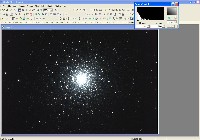
|
Use MaxIM DL to do a Non-Linear Stretch (DDP)
on the RGB Frame, with DDP parameters:
- Background = 1350
- Mid-Level = 3000
RGB file shown after non-linear stretch at right. Note that the color here seems a bit washed out,
but we'll deal with that in Photoshop below.
Save this file as a TIFF file in 16-bit uncompressed form.
|
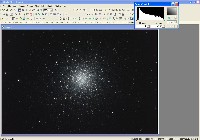
|
|
Step 4: Load Luminance into Photoshop, Reduce Background Noise using Inverted Layer Mask
|
Load the non-linear stretched Luminance frame into Photoshop.
Maximize the size of the Luminance window:
- Menu selection View | Fit on Screen or keyboard-shortcut Ctrl-0
|
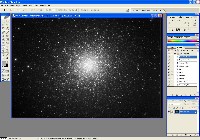
|
At this point, there is generally some noise in the low-signal areas of the image.
The image at right shows some minor noise (magnified to 100% viewing level).
We can blur this noise, but want to protect the stars and other details from the
effect of the blur process.
One method of doing this is to use an Inverted Layer Mask to protect the
brighter portions of the image, as described below.
|
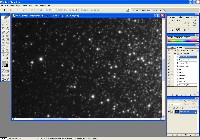
|
First, create an Inverted Layer Mask for the image.
|

|
We want additional protection to the bright areas, so we'll now darken the darkest parts of the layer mask
with Levels.
Invoke the Levels dialog box:
- Menu selection Image | Adjustments | Levels or keyboard-shortcut Ctrl-L
Change the Input Levels in the Levels dialog box to 180, 1.0, 245.
The 180 darkens the darker areas, while the 245 lightens the lighter areas.
These parameters, of course, can be chosen to obtain the desired effect.
|
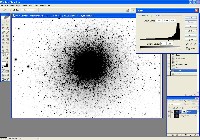
|
Since the Inverted Layer Mask itself is derived from our image, it contains the same
level of noise in the background areas. It's best if we slightly blur the Layer Mask
before proceeding.
Invoke the Gaussian Blur dialog box:
- Menu selection Filter | Blur | Gaussian Blur (no keyboard-shortcut)
Use a blur radius of about 1 or 2 (2 was used here).
|
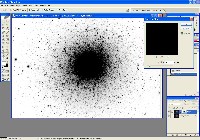
|
Now, make the top layer image active by clicking on its icon (circled in red at the bottom right
in the image). Magnify it enough to clearly see the noise in the background area so that you can
monitor the effect of the following blur command. (To magnify, press Ctrl-0, then press
Ctrl-+ several times.)
Invoke the Gaussian Blur dialog box:
- Menu selection Filter | Blur | Gaussian Blur (no keyboard-shortcut)
Use a blur radius of 2.
To monitor and evaluate the effect of the Blur command, while the Gaussian Blur dialog box
is still open, repeatedly click on the Preview checkbox to see the effect the blur is
having. The background noise should be substantially reduced. The stars may be softened just
a little bit, but that can be recovered with an Unsharp Mask action a little later.
|
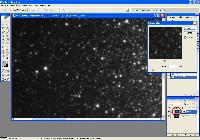
|
Flatten the layers to make the masked blur permanent:
- Menu selection Layer | Flatten Image (no keyboard-shortcut available)
Maximize the size of the image Window (remove prior magnification):
- Menu selection View | Fit on Screen or keyboard-shortcut Ctrl-0
|

|
|
Step 5: Load RGB Image, Reduce Color Noise using Inverted Layer Mask
|
Load the non-linear stretched RGB image. Maximize the size of the RGB:
- Menu selection View | Fit on Screen or keyboard-shortcut Ctrl-0
|

|
As in the Luminance image, there is generally some noise in the low-signal areas of the image.
The image at right shows some significant noise (magnified to 100% viewing level).
We can blur this noise, but want to protect the stars and other details from the
effect of the blur process.
One method of doing this is to use an Inverted Layer Mask to protect the
brighter portions of the image, as described below.
|
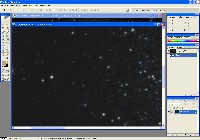
|
Create an Inverted Layer Mask for the image.
However, when you get to step D in that process, don't use the color image as the basis
for the layer mask. Instead, use the Luminance image. It better represents
which areas of the final image will in fact be background and which will be highlights:
Substitute the following in Step D:
- Click on the Luminance Image to make it active Copy its Contents:
- Menu selection Select | All or keyboard-shortcut Ctrl-A
- Menu selection Edit | Copy or keyboard-shortcut Ctrl-C
- Click on the RGB Image to make it active Paste the Luminance into it:
- Menu selection Edit | Paste or keyboard-shortcut Ctrl-V
|
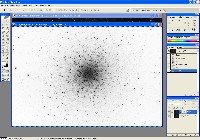
|
We want additional protection to the bright areas, so we'll now darken the darkest parts of the layer mask
with Levels.
Invoke the Levels dialog box:
- Menu selection Image | Adjustments | Levels or keyboard-shortcut Ctrl-L
Change the Input Levels in the Levels dialog box to 50, 1.0, 245.
The 50 darkens the darker areas, while the 245 lightens the lighter areas.
These parameters, of course, can be chosen to obtain the desired effect.
Note that we can afford to be more aggressive with blurring the color (only) data, so we
don't darken this layer mask as much as we did for the Luminance image.
|
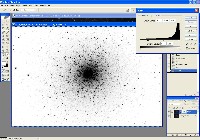
|
Since the Inverted Layer Mask itself is derived from our image, it contains the same
level of noise in the background areas. It's best if we slightly blur the Layer Mask
before proceeding.
Invoke the Gaussian Blur dialog box:
- Menu selection Filter | Blur | Gaussian Blur (no keyboard-shortcut)
Use a blur radius of about 1 or 2 (2 was used here).
|
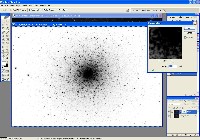
|
Now, make the top layer image active by clicking on its icon (circled in red at the bottom right
in the image). Magnify it enough to clearly see the noise in the background area so that you can
monitor the effect of the following blur command. (To magnify, press Ctrl-0, then press
Ctrl-+ several times.)
Invoke the Gaussian Blur dialog box:
- Menu selection Filter | Blur | Gaussian Blur (no keyboard-shortcut)
Use a blur radius of 2.
To monitor and evaluate the effect of the Blur command, while the Gaussian Blur dialog box
is still open, repeatedly click on the Preview checkbox to see the effect the blur is
having. The background noise should be substantially reduced. Again, we can afford to be more
aggressive blurring the color data as the fine detail will come from the Luminance
layer. Just be careful not to blur so much that you lose color in the small stars.
|
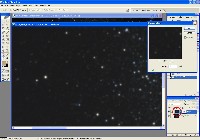
|
Flatten the layers to make the masked blur permanent:
- Menu selection Layer | Flatten Image (no keyboard-shortcut available)
Maximize the size of the image Window (remove prior magnification):
- Menu selection View | Fit on Screen or keyboard-shortcut Ctrl-0
|
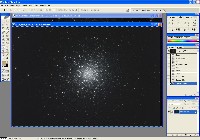
|
|
Step 6: Merge Luminance image into RGB image
|
Click on the Luminance image so make it active. Copy its contents
- Menu selection Select | All or keyboard-shortcut Ctrl-A
- Menu selection Edit | Copy or keyboard-shortcut Ctrl-C
Click on the RGB image to make it active. Paste the Luminance Image onto it.
- Menu selection Edit | Paste or keyboard-shortcut Ctrl-V
Set the Blend Mode to Luminosity
|
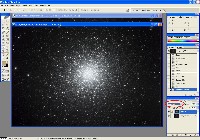
|
The color is looking much too washed out, so we'll add a little Color Saturation at
this point. More adjustments may be needed later after we get the brightness and contrast
where we want them.
Click on the Background layer icon (circled in Red at the bottom right of the image).
Adjust the Color Saturation level of the color layer:
- Menu selection Image | Adjustments | Hue/Saturation or keyboard-shortcut Ctrl-U
- Enter 60 into the Saturation box.
- Click OK
|
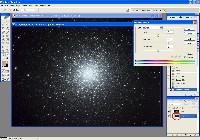
|
Flatten the layers to make the merger permanent:
- Menu selection Layer | Flatten Image (no keyboard-shortcut available)
Click on the Luminance frame and close it, as we won't need it again during this
processing run.
|
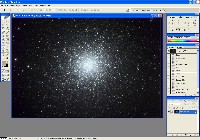
|
|
Step 7: Final Adjustments/Tweaking Image
|
While some of what precedes this step depends on personal preferences of the imager,
all of what follows gets very personal and subjective. At each step of the way, the
imager decides what adjustments will move the image toward his/her final vision.
|
Apply mild Unsharp Mask:
- Menu selection Filter | Sharpen | Unsharp Mask (no keyboard-shortcut)
- Amount - 50%
- Radius - 3.0 Pixels
- Threshhold - 0 Levels
These entries will provide a very small boost in sharpness without invoking too
large a penalty in artifacts. The main artifact to be concerned about is dark
rings around stars that overlay nebulosity. Another artifact that can occur
with too-aggressive Unsharp Masking is hard-edged stars, rather than more natural
looking soft-edged stars. Yet another downside of any sharpening that affects
fine details is that it can sharpen noise as well, and make it more apparent.
|
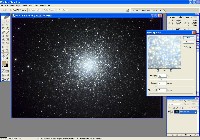
|
This image can handle another, smaller, Unsharp Mask adjustment.
Apply mild Unsharp Mask:
- Menu selection Filter | Sharpen | Unsharp Mask (no keyboard-shortcut)
- Amount - 50%
- Radius - 1.0 Pixels
- Threshhold - 0 Levels
This process sharpens the star edges just a tiny bit more.
|

|
The contrast and brightness looks very close to correct, but we'll do a mild curves to darken the
background just a little bit, and at the same time brighten up the dimmer stars.
First, create an Inverted Layer Mask for the image.
|
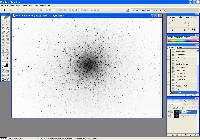
|
We want to primarily affect the darker areas, so we'll add a Levels adjustment here that will brighten the
layer mask where the image is dark, and darken the layer mask where the image is bright.
Invoke the Levels dialog box:
- Menu selection Image | Adjustments | Levels or keyboard-shortcut Ctrl-L
Change the Input Levels in the Levels dialog box to 100, 1.0, 245.
The 100 darkens the darker areas, while the 245 lightens the lighter areas.
These parameters, of course, can be chosen to obtain the desired effect.
|
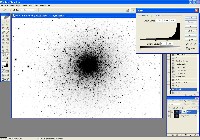
|
Since the Inverted Layer Mask itself is derived from our image, it contains the same
level of noise in the background areas. It's best if we slightly blur the Layer Mask
before proceeding.
Invoke the Gaussian Blur dialog box:
- Menu selection Filter | Blur | Gaussian Blur (no keyboard-shortcut)
Use a blur radius of about 1 or 2 (1 was used here).
|

|
Now, make the top layer image active by clicking on its icon (circled in red at the bottom right
in the image).
Apply Curves to increase contrast/darken dimmer areas:
- Menu selection Image | Adjustments | Curves (no keyboard-shortcut)
- Set one point and enter 190 for the Input and 200 for the Output.
This point will brighten the stars in the dimmer portions of the image.
- Set one point and enter 64 for the Input and 59 for the Output.
This point will darken the dimmer portions of the image.
Flatten the layers to make the Curves adjustment permanent:
- Menu selection Layer | Flatten Image (no keyboard-shortcut available)
|
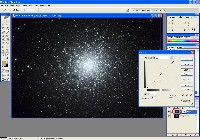
|
At this point, I think the image could stand just a bit more Color Saturation. We want to be careful, however,
not to boost the color of the background area and/or any color noise. One technique is to do the color saturation
increase on a layer protected by a Positive Layer Mask.
First, create a Positive Layer Mask for the image.
|
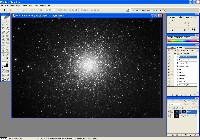
|
Now, make the top layer image active by clicking on its icon (circled in red at the bottom right
in the image).
Invoke the Hue/Saturation dialog box:
- Menu selection Image | Adjustments | Hue/Saturation (no keyboard-shortcut)
Set the Saturation to 30.
Notice that the central area of the galaxy gets a mild saturation boost, while the galaxy
halo and background don't change.
Flatten the layers to make the Color Saturation boost permanent:
- Menu selection Layer | Flatten Image (no keyboard-shortcut available)
|
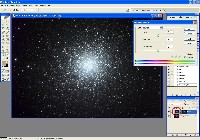
|
At some point before finalizing the image, it's a good idea to magnify it and look for tiny defects that can
be fixed with the Clone Stamp. (See red-circled icon on toolbar on left side of image).
Clone Stamp Image Defects:
- Select Clone Stamp Tool
- Set a suitable Brush size - large enough to cover the defects, but small enough so as not to
cover too much image at a time.
- Alt-Click near a defect
- Click over top the defect to copy the tiny part of the image from one location over the defect.
|

|
This adjustment could be done at any time, but the raw data files have North at the bottom,
rather than the more conventional North at the top.
Rotate image 180 degrees.
- Menu selection Image | Rotate Canvas | 180 degrees (no keyboard-shortcut)
|
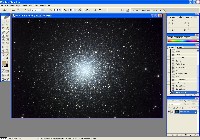
|
The image has some lines and border issues due to the CCDSharp Deconvolution routine
and the dithered guiding (used to help remove CCD chip column noise).
|
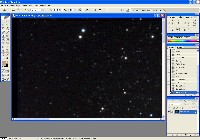
|
Select the Crop tool from the toolbar (circled in red on the left side of the image).
Outline the area that is within the border areas and press the Enter key.
|
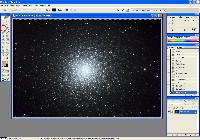
|
|
Step 8: Save the Results
|
Save a TIFF version of the image:
- Menu selection File | Save As (no keyboard-shortcut)
- Supply a name for the file (should be different from the RGB file in case you
want to start over at some point).
- Select None for Image Compression to maintain the highest quality
of the finished image.
|
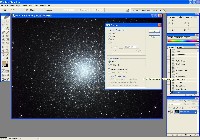
|
If you want to share the image on the web or via email, save a JPEG version of the image:
- Menu selection Image | Duplicate (no keyboard-shortcut)
- Menu selection Image | Mode | 8-Bits/Channel (no keyboard-shortcut)
- Menu selection File | Save As (no keyboard-shortcut)
- Supply a name for the file.
- Select a Quality of 9 to maintain a high quality in
the saved image.
|
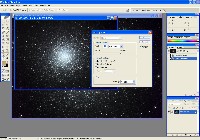
|
Enjoy the image, and start planning the next one...
|
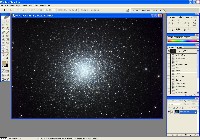
|









































